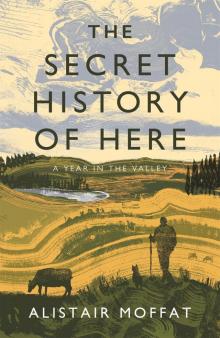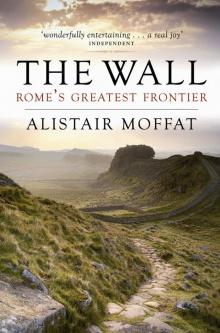- Home
- Alistair Moffat
Britain’s Last Frontier Page 12
Britain’s Last Frontier Read online
Page 12
Meanwhile, the front lines closed on each other so that both sides were now able to see clearly the enemy they had to kill. Under their metal helmets and with their shields up to deflect missiles, the auxiliaries glared at the half-naked, tattooed warriors with the spiked lime-washed hair. And then the first orders were roared across the battlefield and trumpets sounded. Volleys of javelins flew into the air and the Caledonians responded with spears. In order for javelins to be effective, men needed to be within 30 metres of their targets. Tacitus’s excellent narrative continues:
The battle opened with fighting at long range: the Britons not only stood firm but displayed skill in parrying the javelins of our men with their massive swords or catching them on their short shields, while hurling a great rain of spears themselves. Then Agricola exhorted the four Batavian and two Tungrian cohorts to fight hand to hand at sword’s point. This was what they had been trained for in their long service, whereas it was awkward for the enemy with their small shields and enormous swords – for the swords of the Britons, having no points, were unsuited for a cut and thrust struggle and close-quarters battle. So the Batavians rained blows indiscriminately, struck with their shield-bosses, and stabbed in the face. When they had cut down those posted on the plain, they started to push their battle-line up the hillsides. The other cohorts, in eager competition, pressed forward to attack, and cut down the nearest of the enemy. In the haste of victory a good many were left half-dead or untouched.
Agricola had ordered the Batavians, Tungrians and British regiments to open out their ranks not only to extend their line but also so that the scythed chariots could be neutralised. But in the tussocky, rough and perhaps boggy ground, the Roman advance appeared to stall and falter. It may be that it was then Calgacus saw his chance. Tacitus again: ‘The Britons stationed on the hilltops had as yet taken no part in the battle, and, not being involved, were regarding our small numbers with contempt. Now they began gradually to descend and to work their way round the rear of the winning side. But Agricola, who had feared this very move, sent four regiments of cavalry, which had been reserved for the emergencies of battle, to block them as they came on. The more ferociously they charged, the more vigorously he drove them back and scattered them in flight.’
This was the turning point of the battle. Having lured Calgacus off the hillside, Agricola had then to defeat him decisively on the plains, not only prevent a fatal encirclement of his army but also drive the Caledonians from the field. With only his cavalry, without the intervention of the legions, he succeeded. ‘Thus the Britons’ tactics recoiled on themselves. The cavalry regiments, on the general’s command, wheeled round from the front of the battle and charged the enemy in the rear. Now indeed a vast and grim spectacle unfolded on the open plains: the cavalry pursued, inflicted wounds, took captives, and, as fresh foes appeared, butchered their prisoners.’
According to Tacitus, the Battle of the Graupian Mountain turned into a rout and 10,000 Caledonians were killed, no doubt most of them falling as they fled. Only 360 Romans died. One of these numbers seems suspiciously rounded and can only be an estimate while the other is surprisingly small. While Tacitus may have risked exaggeration, he was nevertheless right to report an emphatic Roman victory. At the very ends of the Earth, against overwhelming odds, in difficult and unfamiliar territory and in the shadow of the mountains, Roman soldiers had crushed a barbarian army. ‘At dawn the next day,’ wrote Tacitus, ‘the scale of the victory was more apparent: the silence of desolation on all sides, the hills lonely, homesteads smouldering in the distance, not a man to encounter the scouts.’
Emphatic though it was – and, in the long story of the Highland Line, no greater battle was fought – the victory at the Graupian Mountain had no lasting political impact. With the summer already over, Agricola turned his army southwards and led them to winter quarters. Meanwhile the British Fleet sailed as far north as Shetland and circumnavigated what its captains must have thought of as the conquered island of Britain. But it was a fleeting moment of triumph. In the angry, concise phrase, ‘Britain was completely conquered – and straight away let go’, Tacitus expressed his disgust at the actions of the Emperor Domitian. Trouble was bubbling up elsewhere in the Empire and he ordered the transfer of troops from Britain. Rome retreated south and, by AD 90, the Caledonian kings were once again masters of Scotland north of the Forth.
The battle itself may have had little long-term significance but the transmission of its story did. In a fascinating footnote, it named – wrongly – some of Scotland’s most impressive geography. When Tacitus’s manuscript was first printed in Italy between 1475 and 1480 by Francesco dal Pozzo, a mistake was made. Instead of ‘the Graupian Mountain’, the Italian editors rendered it as ‘the Grampian Mountain’ and the mistaken name has stuck.
6
The History of the Sun
A BRILLIANT AMERICAN scientist, Jack Eddy, understood how delicate was the balance between the history of the Sun and the history and health of the Earth. By gathering historical data reaching back to Galileo and even beyond and by using new, unexpected sources in an enormously influential paper published in 1976, he offered a much clearer picture of a prime cause of climate change.
Eddy studied the period known as the Little Ice Age. This prolonged sequence of bad weather lasted many centuries, from the early 14th to the mid 19th. There were intervals of relative relief but records showed that there were especially severe winters and poor summers from 1460–1550, 1645–1715 and 1790–1820. Using the pioneering work of Victorian scientists, Edward Maunder and Gustav Spörer, Eddy realised that these long cold and wet periods coincided with changes on the surface of the Sun.
Since the earliest records were kept in China in 324 BC, observers have been able to see with the naked eye black spots on the Sun, usually when it is weak, at sunrise and sunset, and can be looked at directly. Later, astronomers could avoid the blinding dazzle by looking through glass, darkly. By the time Galileo had revolutionised techniques and understandings of the heavens, regular records of what was known as sunspot activity were being kept. From an analysis of these, Jack Eddy realised that the three sequences of prolonged bad weather during the Little Ice Age corresponded closely with low or no counts of sunspots.
At first reading, this may seem counter-intuitive. These black areas can be huge, sometimes 80,000 kilometres in circumference, larger than the Earth itself. Surely fewer black spots on the surface of the Sun should make it shine more brightly and send out even more warmth into the solar system. What Eddy explained in 1976 was that the opposite was true. The margins of sunspots turn out to be much hotter than the rest of the surface of the Sun and the more there are, the greater the brightness and heat, what is called the Solar Constant.
During the second half of the 17th century, astronomers saw very few sunspots. In what Jack Eddy called the Maunder Minimum (after the 19th-century scientist who first noticed it), there was a series of short and wet summers followed by very cold winters. This particularly affected tree growth and, in a fascinating aside, music-loving scientists believe that the birth of the great violin maker, Antonio Stradivari, a year before the onset of the Maunder Minimum, was very significant. His famous instruments are thought to have unrivalled tone because of the slow-growing, very dense wood he used.
In his paper of 1976, Eddy showed that, as a direct result of a very small variation, as little as 0.1 per cent, in the Solar Constant caused by the absence of sunspots, the Earth’s weather changed dramatically. Across a wide swathe of Northern Europe, the summer of 1695 saw weeks of heavy rain and flooding and then a sudden autumn frost blackened ripening crops over a huge area. From Estonia in the eastern Baltic, through Scandinavia and in Scotland, there was wholesale crop failure and a meagre or nonexistent harvest. A bitter winter followed the autumn frost and people slowly began to starve. 1696 was little better as rain fell throughout the summer. Children and old people were the first to die as the snows came early, falling in October. And
, by the time of the thaws and the snowmelt of the following spring, many corpses were revealed.
In Aberdeenshire, the effects of what was counted as a famine on a biblical scale were recalled by a minister, the Rev. Alexander Johnson. In the central, normally fertile parishes of Mar and the Garioch, there was devastation:
Of 16 families that resided at the farm of Littertie, 13 were extinguished. On the estate of Greens, which presently accommodates 169 individuals, 3 families (the proprietor’s included) only survived. The extensive farms of Touchar, Greeness, Overhill and Burnshide of Idoch, now containing more than 100 souls, together with some farms of the parish of Turriff, being entirely desolated, were converted into a sheep-walk by the Errol Family, to whom they belonged. The inhabitants of the parish in general were diminished by death to one half, or as some affirm, to one fourth of the preceding number.
It is likely that, over the whole of Aberdeenshire, a fifth of the population of the county perished in the years after 1695 and, in the Highlands, the death rate was just as severe. Many emigrated, often to Ulster, and deserted landscapes such as those described by Alexander Johnson were seen everywhere in the north.
Perhaps on humanitarian grounds, certainly for economic reasons, landowners in the generation following the famine were determined to improve agricultural methods. Sir Archibald Grant’s father bought the Monymusk Estate in 1713, never having seen it for himself. It lay to the south of Bennachie and, when the young Grant arrived, he wrote a depressing description of what he found – essentially the aftermath of the famine:
The house was an old castle with battlements and six different roofs of varying heights and directions, confusedly and inconveniently combined, and all rotten, with two wings more modern, of two stories [sic] only, the half of windows of the higher rising above the roofs, with granaries, stables and houses for all cattle, and of the vermin attending them, close adjoining, and with the heath and muir reaching in angles or gushets to the gate, and much heath near, and what land near the farms was in culture [cultivation], by which their cattle and dung were always at the door. The whole land raised and uneven, and full of stones, many of them very large, of a hard iron quality, and all the rigs crooked in the shape of an S, and very high and full of noxious weeds and poor, being worn out by culture, without proper manure or tillage. Much of the land and muir near the house, poor and boggy; the rivulet that runs before the house in pits and shallow streams, often varying channel with banks, always ragged and broken. The people poor, ignorant and slothful: and ingrained enemies to planting, enclosing or any improvements or cleanness; no keeping of sheep or cattle or roads but four months when oats and barley, which was the only sorts of their grain, was on ground. The farm houses, and even corn mills and mains and school, all poor dirty huts, pulled in pieces for manure or fell of themselves almost each alternate year.
The Parish State
By the 18th century, Scotland was a nation of parishes, more than 900 in all, and such was the grip of the Kirk on local life that this system amounted to a state within a state. Kirk elders were elected for life to act as boards of governors. They selected the minister each time there was a vacancy and were ultimately more powerful. Parishes were the lowest, most local rung of government and they had three key functions. The collection and distribution of funds for the poor was the framework of a very elementary welfare state. Schools were paid for and supervised by the parish and the Kirk Session supervised the morals of the parishioners. While more serious offences were referred to higher authority, parish courts dealt with assault, theft, wife-beating and sexual behaviour. If anyone wished to move from one parish to another, they required a passport known as a testificat, a certificate of good behaviour that required to be agreed and signed by the minister. In 1712, the Toleration Act allowed the Episcopalian Church to hold services and the legislation was much resented for it broke the monopoly hold of the Kirk. By the 1750s, the judicial powers of the parish courts were on the wane and they increasingly focused on sexual offences. A deliberately humiliating tariff of punishments was devised. Offenders had to appear before the congregation wearing sackcloth each Sunday. Three appearances were demanded for fornicators, six for a second offence and twenty-six for adulterers, and those who committed incest were forced to appear every Sunday for a year.
In essence, Grant was describing the landscape of medieval Scotland, a rural landscape that had lain unchanged for many centuries. It was open, windswept, without fences or hedges, and there were few trees to provide shelter. Land was let in small parcels to cottars who tilled the inbye fields and grazed animals on what was called the muir or moorland. A scatter of farm cottages patterned the countryside and the holdings attached to each were not laid out in the tidy pattern of modern fields. Instead, open rigs were ploughed and planted usually only with oats or barley (the S-shape Grant complained about was caused by the need for a cumbersome plough team of oxen to begin their turn early at the end of each furrow). In the ditches between the rigs, thistles, corncockle and other weeds were allowed to grow tall so that the cottars could cut them in the late autumn for winter forage for their beasts. Over centuries of tillage, stones had been tumbled into the ditches, something Grant remarked upon.
There were no machines to help with heavy labour. Cottars depended exclusively on muscle power – their own and that of oxen and horses – to do all the work of farming and the landscape reflected those limitations. It was certainly not picturesque, and only occasionally beautiful, but it was very quiet. In an age before the clank of machinery or, much later, the hum of engines, rural Scotland heard only the bleating ewes and lambs, the trumpeting of cattle and the cry and shriek of birds. And, on moonless nights, the hushed countryside could be a dangerous place, black-dark with no roads or outside lights. It is little wonder that people stayed indoors, huddled around the fire, talking of ghosts, ghouls and the fell creatures of the silent night.
The tumbledown houses noted by Archibald Grant may well have been snug enough. Most will have been built in the common long-house shape with living quarters at one end and a byre at the other. Dividing humans and beasts was a passageway called a through-gang and it led directly from the front door to the back. Often there was a midden near a door, against the wall of the house, a rubbish tip of organic matter (there was no other sort until the modern era) that would rot down and be used to muck the inbye fields after the harvest. Abutting the back door was usually a yard, somewhere beasts could be led out and tethered for milking or some other purpose. Because cottages were dark and often smoky, most domestic work was done outside if the weather allowed. Surprisingly, at least for delicate modern nostrils, much was done by the midden.
Inside a cottage a constant fire burned or smouldered. As many did, the cottars at Monymusk had access to peat. Some cottages acquired chimneys and a fireplace but others persisted with the traditional down-hearth. This was a central fire whose smoke drifted upwards and seeped through the thatch. Made safe by a circle of large, flat and blackened stones, it was used for cooking as well as heat and light, and cooking pots sat on those stones that projected a little into the embers. Families sat around the fire on low stools or on the floor of brackens or straw over beaten earth to eat and talk and they slept in its glow.
These simple little houses may seem primitive, leaky, shared with mice, rats and fleas, but they were usually warm. Nowadays, people rarely arrive home utterly exhausted, soaked to the bone, or numbed by the intense cold of the winter. We are not often so tired and hungry that our bodies shake because of a lack of calories. In the relatively recent past, Scots who worked on the land regularly suffered all of these extremes and their dark little cottages were a welcome place of warmth, shelter from the elements and somewhere they could fill their hollow bellies with hot food and enjoy the firelit company of their families.
What Archibald Grant saw at Monymusk was a pressing need to change that ancient way of life. In order to avoid the appalling privations of the late 1690s and to
make the most of his decaying estate, he began to take action. His immediate priority was trees.
By indulgence of a very worthy father, I was allowed in 1716, though very young, to begin to enclose and plant and provide and prepare nurseries. At the time there was not one acre on the whole estate enclosed, nor any timber upon it, but a few elms, sycamore and ash about a small kitchen garden adjoining the house, and some straggling trees at some of the farm yards, with a small copse wood, not enclosed and dwarfish and browsed by sheep and cattle.
Grant was only 20 years old when he began to have trees planted but even he could not hope to see them mature. What his saplings in their shelter belts and avenues would eventually achieve was the clear enclosure of land into fields of a workable size. Throughout the 17th and 18th centuries, landowners pushed hard and sometimes ruthlessly to change the ancient pattern of farming and there was an undoubted and heavy human cost. Improvement was forced through but at a price that is sometimes ignored amidst the general approval of progress.
By definition, enclosure ended ancient customary rights whereby small farmers and cottars could make use of what had been seen as common land. When powerful landowners claimed ownership of commons and also consolidated estates, they evicted cottars and incorporated their smallholdings into much larger, more commercial farms. This process became known as ‘the Lowland Clearances’, a time of brutal, enforced social change much less recognised than the later Highland Clearances. Mirroring the later fate of crofters, cottars were swept off land their families had farmed for many generations, their snug little houses were often levelled and the old arrangement of inbye, outbye and the common muir consigned to history.

 The Secret History of Here
The Secret History of Here The Night Before Morning
The Night Before Morning To the Island of Tides
To the Island of Tides Arthur and the Lost Kingdoms
Arthur and the Lost Kingdoms Britain’s Last Frontier
Britain’s Last Frontier The Faded Map: The Lost Kingdoms of Scotland
The Faded Map: The Lost Kingdoms of Scotland The Wall
The Wall